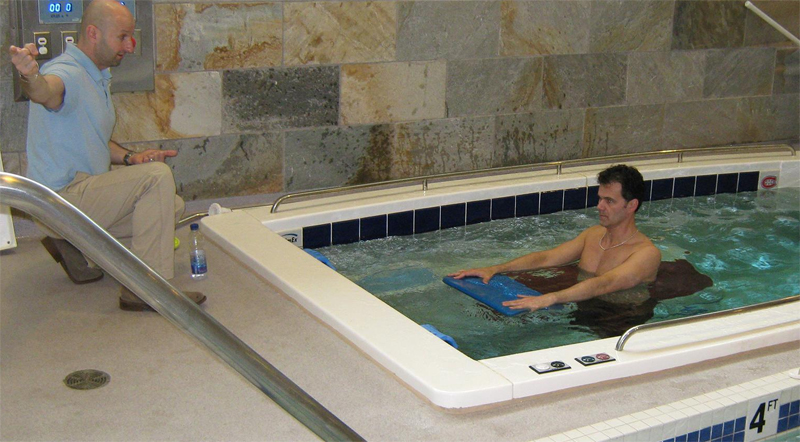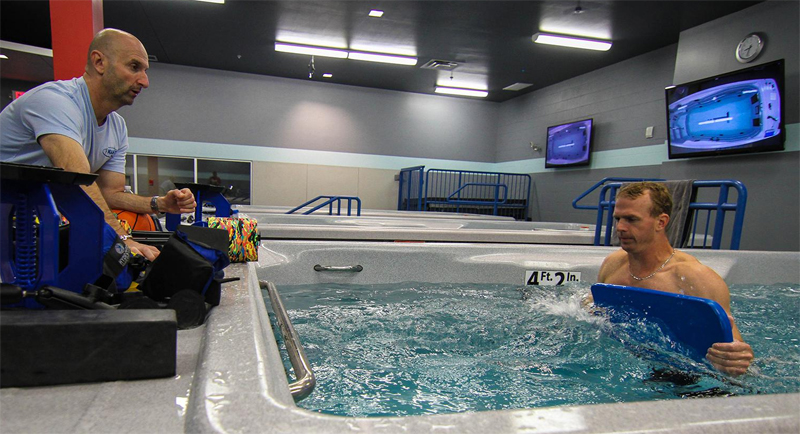Aquatic Pre-Hab for Joint Replacement
By 2030, the demand for primary total hip arthroplasties is estimated to grow by 174% to 572,000. The demand for primary total knee arthroplasties is projected to grow by 673% to 3.48 million procedures.
Pre-surgical or prehabilitation (prehab) programs have been gaining increased popularity and show promising results in getting clients moving quicker after surgery. Prehab can be defined as an individualized physical conditioning program to improve strength, endurance, and range of motion prior to surgery.

I have found in my experience that by incorporating an aquatic program six or more weeks prior to surgery can have significant benefit post-operatively.
A multicenter study performed at New England Baptist Hospital, Beth Israel Deaconess Medical Center and Harvard Medical School found that knee- and hip-replacement surgery patients who had participated in prehab for just six weeks prior to surgeries reduced the need for inpatient rehabilitation by 73 percent. This study involved water-and land-based strength training, plus aerobic and flexibility exercises.
Why Use the Water to Help with Pre-hab?
Reduced Pain & Swelling
Clients awaiting joint replacement surgery are usually in a significant amount of pain. They may experience pain not only at the specific joint but also in corresponding joints that have compensated for improper biomechanics. Using the water’s unloading properties to reduce pain, as well as the hydrostatic pressure to help with swelling reduction, are tremendous benefits.
Restore Range of Motion (ROM)/Muscle Balance
I always tell my clients, “Motion is Lotion.” This means that the more you move correctly, the better you will feel. Gaining as much ROM prior to joint replacement is very important. I also share, “The doctor will be replacing your joint, not your ligaments, tendons or muscles. The more muscle balance we can get the better you will do post operatively.” I give the example of a worn out tire on a car. Over time the cars suspension adapts to that worn tire and pulls out of alignment. The replaced joint represents the new tire; now we have to realign the suspension so everything rides correctly.
In the water using flotation equipment on the lower extremities allows the client to gain much more ROM.
Buoyancy unloads the joint and assists the motion, but more importantly the client has control over the movement. If try to manually stretch a client, he/she is automatically guarded, no matter how much I remind them to “relax”. Moving freely in the water, the client is more likely to push their ROM than if I stretch him/her manually.
Improve Strength
Pain causes muscle inhibition and hence muscle weakening. Neuromuscular control needs to be restored prior to surgery in order to facilitate muscle recovery post-operatively. The stronger the muscles are, the faster the recovery. Strengthening exercises to help balance all muscle groups are much easier and comfortably performed in the water. Water provides an accommodating three-dimensional resistance which allows multiple muscle groups to be strengthened simultaneously.
Improve Proprioceptive Awareness & Normal Movement Patterns
Any functional movement depends on the coordination and fine tuning of the neuromuscular system. Joint degeneration affects the soft tissues that contain proprioceptors, which will cause significant reduction in the awareness of joint movement.
Proprioceptive exercises can be be started prior to surgery to stimulate the neuromuscular mechanisms and make them more responsive after surgery. The water provides a surrounding proprioceptive enriched environment to help restore neuromuscular function, including balance and proprioception.

Improve Gait
Degeneration of lower extremity joint will commonly result in a compensated gait pattern. This pattern is often continued, even after surgery, because of abnormal motor patterns. Use the water to correct gait patterns prior to surgery, which will assist with alignment, weight shift and proprioceptive input, and therefore facilitate a normal post-op gait pattern.
Client Education
Surgeons often do not tell the client what they will experience post operatively. Thus, another benefit of prehab is the opportunity to educate the client on the post-op process. Clients often compare themselves to other people who have had a similar surgery, which can lead to frustration. By educating the client and with the understanding that everyone progresses at a different rate.
In my experience, by utilizing the water for prehabilitation prior to a total joint replacement is one of the best ways to get clients moving and feeling better faster!
If you’re interested in sponsoring a Medically Based Aquatics (MBA) course at your facility, please contact Rick McAvoy at rick@rickmcavoyaquatics.com
Dr. Rick McAvoy has specialized in Aquatic Physical Therapy and Sports Performance for over 30 years and promotes aquatic fitness, rehab and training. He is the Owner of Rick McAvoy Aquatics, an Aquatic Fitness and Sports Performance Training and Consulting Company. Rick is also a published author and researcher in the field of Aquatic Therapy and Fitness as well as Sports Performance.

